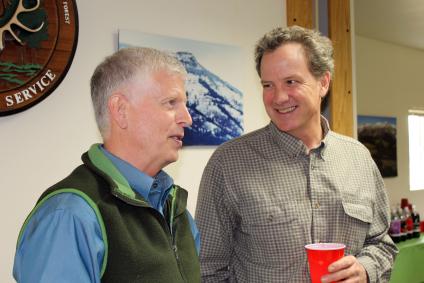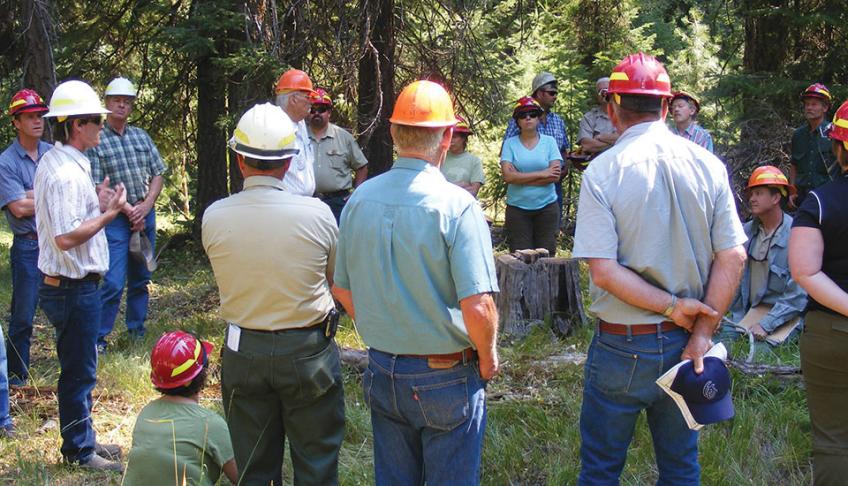Show up every day and give your best: Bill Gamble's recipe for over 30 years of service
OREGON—After over 30 years of service with the Forest Service, the La Grande Ranger District bids farewell to its district ranger, Bill Gamble, who is retiring at the end of June. We sat down with Bill to discuss his time in the Forest Service and as the district ranger in La Grande. This is his story.
My first job with the Forest Service started in 1987 as a seasonal marking crew member on the South Lake Tahoe Basin Management Unit in California. I was about halfway through my college education and hadn’t really decided how I wanted to apply myself in the field of natural resources. Working as a marking crew member was a lovely experience. We had a cabin right on Lake Tahoe as part of our housing, and one of the crew even had a ski boat that we moored outside our cabin on the lake. It was a great introduction into the Forest Service, but I really wanted to see all the opportunities that were out there for natural resource forester work.
So, I took a break from the Forest Service to take an internship with Weyerhaeuser in western Washington, providing me an opportunity to see how private industrial forestry works. While a great experience, this internship prompted me to return to the Forest Service, as I realized multiple-use management to accomplish a myriad of objectives was a better fit for my interests and land ethic.
I remember standing in Peavy Hall, at Oregon State University in the fall of ’88, and on the wall, I saw a flyer that was asking people to sign up for cooperative education programs with the Forest Service. Not wanting to leave any stone unturned, I applied and had an interview with some very nice people from the agency. Golly, it took probably four months before I heard back and received a letter offering me a cooperative education position as a tree improvement forester on the Malheur National Forest in Grant County, Oregon.
In my first permanent position with the agency, I was able to start applying myself as a forester; in this case, in tree improvement. As part of my job, we would go around the forest and identify trees that expressed quality traits and gather cones from them, then plant their progeny in evaluation plantations and seed orchards. Then, over time, we would evaluate their performance growing across a range of sites and emphasize future seed collection from the best performing trees. This tree improvement program was really the Forest Service dipping its toes into the idea that we could capitalize on the genetics of our forest trees. With this work, we were able to improve planting success and ultimately improve tree growth through the process.
But, as the agency’s mission shifted, there became less importance in rapidly growing trees, and the program faded away. By then, it was 1994 and I was directly reassigned as a silviculturist to the Prairie City Ranger District located on the Malheur.
Between ’94 and ’02, I worked as a certified silviculturist, while also doing several details as a hydrologist supporting interdisciplinary teams. In the early 2000s, I also met my wife Karen, who worked as a GIS analyst for the Malheur. In the summer of 2002, she was offered a GIS position outside the region in Idaho, and I tagged along and got a job as a hydrologist on the Payette National Forest, where I worked for about six years.
We had a couple of interesting natural disturbances happen while working on the Payette. One of these disturbances was an F2 tornado that touched down in the middle of our district, which was named the Bear Tornado. At that time, the ranger must have seen something in me and asked me to lead the tornado recovery team. So, I moved from hydrology into a National Environmental Policy Act planner position. Then, shortly after that, there was a large fire just outside of the community. I was asked to lead that effort up, and evidently did well enough that they suggested that I think about moving into a leadership position.
By this point, it was about 2006-2007, when I did my first ranger detail at the Weiser Ranger District on the Payette National Forest. After that detail, I took another ranger assignment in Ely, Nevada, where I was able to assist the district with transitioning to a new full-time ranger after their long-time ranger fell ill.
It was while I was in Nevada that I received an offer for my first official ranger position on the Diamond Lake Ranger District on the Umpqua National Forest and worked there until December 2011, when I was offered the position of district ranger for the La Grande Ranger District on the Wallowa-Whitman National Forest, where I have been ever since.
Since I’ve been in the ranger realm, I have done a couple of details. One as a deputy forest supervisor, and in 2015, I detailed as the forest supervisor for the Umatilla National Forest. This was a very challenging and rewarding experience as we dealt with extreme fire conditions threatening communities and landscapes across the region, including several major fires on the Umatilla.
As I draw closer to my retirement, I get to look back fondly at the amazing opportunities I have had to work in beautiful landscapes and the amazing people I have gotten to share them with. Some of my fondest memories with the Forest Service have been working with teams coming together under a shared vision to get things done.
One of the best examples of this for me was the Bear Tornado. It was one of the first times that I had been thrust into a leadership role, and an opportunity for me to realize that we can make a bigger difference for all natural resources through leading people. In this instance, our team was able to complete our analysis and have a signed decision guiding environmentally thoughtful and economically efficient recovery of a tornado-damaged landscape within 82 days after the tornado touched down. That was ‘NEPA light speed’ and an example of what we can accomplish when we work together under a common vision.
While I have had a successful career advocating for trees as a forester, and advocating for water and soil as a hydrologist, the opportunity to lead incredibly committed, passionate and dedicated people is where we can make an even bigger difference to the natural resources and communities we serve.
Looking ahead, I hope that the Forest Service continues to emphasis the relevance and importance of our work to the public. To be able to show the members of our community that the work we do, caring for and stewarding our nation’s forests, is meaningful. Over the past decade, we have been very successful in advancing restoration of our forest landscape, as well as our watersheds, and I would love to see the next ranger come in, take the reins and build on these successes through continued empowerment of the dedicated employees who make this holistic work happen.
As my time as a full-time employee with the Forest Service comes to an end, I look forward to the next chapter in my life, retirement. One of my main goals is to really embrace being in the moment, not always having my mind filled with the distractions that come from being a district ranger. Also, I look forward to spending time with my four grandkids and playing a larger role in their lives. If I can just be a fraction of the influence on them that my grandfather was to me, I will feel like I have succeeded.
Getting to engage in long-ignored hobbies and spending more time with Karen is also something that I look forward to. So, we will be doing a lot of hiking, biking and camping, and just enjoying our local landscape after not having much opportunity to enjoy it between Karen's support to incident management teams over the years and my responsibilities as a ranger.
My final message for the team is just be a part of it. Know deep in your hearts that what we do matters. Show up every day, give it your best, always treat each other and our public with respect and professionalism, and that's a recipe for culminating your career in a manner where you can feel really good about what you've done and know that you've made a positive difference.



